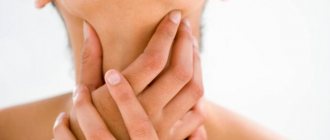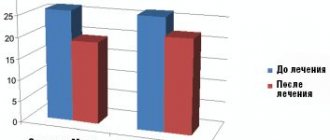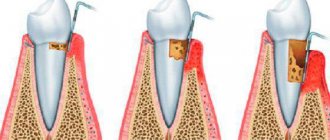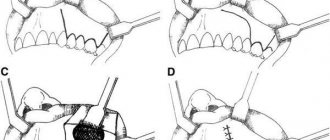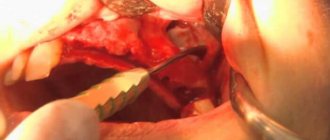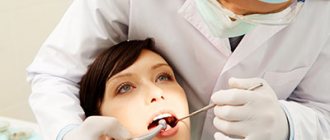Many people experience such an unpleasant phenomenon as xerostomia, or a constant feeling of complete dryness in the mouth. This dryness occurs due to dysfunction of the salivary glands, but it is not considered an independent disease; it is usually a consequence of more serious health problems. However, it is impossible to treat xerostomia with disdain; it is better to identify this condition in time, establish its causes and begin to treat, because any problem tends to worsen over time. And life with constant dry mouth becomes less comfortable, and eating sometimes becomes just an unpleasant chore.
Xerostomia
Xerostomia (ICD code 10 - K 11.7) is pathological dryness in the oral cavity, caused by a decrease or complete cessation of salivation. The name of the concept in Latin, Xerostomia, comes from the Greek xero- (dryness) + -stoma (mouth). This is not a separate disease, but a symptom associated with another pathological process. Xerostomia is manifested by perversion of taste sensitivity and distortion of sensations in the oral cavity.
Specialists from the Yanino-1 and Vsevolozhsk branches of the West Dental family dentistry clinic will help identify the cause of this symptom and determine the specific treatment for all signs and pathological conditions. To do this, doctors have all the necessary high-tech equipment and sterilized instruments.
Causes
Many reasons lead to xerostomia, but the most basic is the use of medications, the secondary manifestation of which is dryness of the mucous membranes of the oral cavity. For temporary use, this is a harmless effect, but for a long course, an alternative should be chosen.
The main list of drugs that cause xerostomia, as one of the possible side symptoms:
- painkillers;
- muscle relaxants;
- bronchodilators;
- anticonvulsants and antitumor;
- lowering pressure;
- diuretics;
- tranquilizers.
In addition to medications in the oral cavity, xerostomia is caused by:
- diabetes;
- hypertension;
- iron deficiency;
- HIV infection;
- rheumatism;
- dysfunction of the thyroid gland;
- taking multiple medications at once;
- elderly age;
- radiation therapy;
- Sjögren's syndrome - dryness of all mucous membranes in the body.
When the nasal passages are blocked and there is a runny nose or a decrease in the tone of the soft palate, breathing at night occurs through the mouth, which is why the mucous membranes dry out in the morning. A temporary phenomenon can occur with any dehydration of the body: diarrhea, vomiting, fever, low fluid intake.
Frequent rinsing of the mouth with concentrated solutions creates all the conditions for the development of atrophy of the salivary glands and dryness of the mucous membranes.
Xerostomia is dry mouth that occurs as a result of a decrease or complete cessation of salivation [10].
Patients suffering from xerostomia are bothered by burning and itching (“burning mouth syndrome”), impaired taste, difficulty speaking, swallowing food (especially dry food), wearing dentures, and frequent injury to the oral mucosa. In this regard, the need for fluid increases, especially during meals, and there is a need for frequent use of products that maintain oral moisture [7].
The main clinical signs associated with xerostomia and hypofunction of the salivary glands include: loss of luster of the oral mucosa and its atrophic changes, the appearance of fissures and lobules on the back of the tongue, and the development of angular cheilitis. Dysbiotic changes and relapses of candidiasis often occur. There is an increase in the intensity of dental caries, the appearance of carious cavities on surfaces that are usually resistant to damage.
The causes of xerostomia can be taking medications, radiation therapy (local and general irradiation), constant stress, old and senile age, and systemic diseases.
Often xerostomia is a consequence of the use of medications. Today, more than 400 drugs are known that have the ability to cause dryness and induce hypofunction of the salivary glands. Among them are anticholinergic, anorexigenic and antihistamines, antidepressants, psychotropic and antihypertensive drugs, diuretics, etc.
In commonly used dosages, these drugs do not damage the structure of the salivary glands; their effect is reversible: withdrawal of the drug leads to the disappearance of dry mouth [8].
When conducting radiation therapy in the head and neck area, according to a number of researchers [1], the rate of salivation at rest decreases by 50% 24 hours after receiving a dose of 2.25 Gy. During treatment (after 6 weeks) (dose of 60 Gy per field/fraction), the decrease in salivation already exceeds 75%. In most cases, decreased salivary gland function and associated xerostomia are irreversible. For prevention purposes, radiation oncologists recommend shielding the salivary glands from the full dose of radiation [1, 8].
Xerostomia and hypofunction of the salivary glands are closely associated with a number of systemic diseases such as rheumatoid conditions, hypertension, diabetes mellitus, cystofibrosis, some neurological conditions, and depression. The prototype of rheumatoid conditions is Sjogren's syndrome [3].
Sjogren's syndrome can be idiopathic (primary), or develop against the background of other rheumatic diseases, such as rheumatoid arthritis, systemic lupus erythematosus, systemic scleroderma. In its early stages, there may be slight changes in the rate of salivation. But as the disease progresses, the rate of salivation gradually decreases due to the slow destruction of the gland parenchyma by lymphoreticular cell infiltrate, irreversible degeneration of acinar cells and severe atrophy [3]. Xerostomia is also associated with a number of widespread disorders and diseases, which include hypertension and diabetes mellitus [9].
The prevalence of xerostomia in older people, according to various authors, ranges from 10 to 61%, and xerostomia is more common in women. It was found that the level of salivation from the parotid salivary glands practically does not change, which indicates their large secretory reserve. The rate of saliva secretion by the submandibular and minor salivary glands may decrease slightly. Drug therapy and systemic diseases mainly affect the function of the submandibular salivary gland [5, 10].
Currently, there are several methods for relieving xerostomia. Stimulating secretion is the optimal treatment method for patients who have preserved the functional activity of the salivary glands. Therapeutic techniques for stimulating secretion can be local or systemic. Chewing gum, mint, inert substances such as paraffin or sucking sour candies increase salivation. However, their effect is fleeting and requires frequent repetition. In some patients, substances such as citric acid cause irritation of the mucous membrane, and if used frequently, they can contribute to demineralization of the enamel. Sugar-containing secretagogues may increase the risk of developing caries. A more conservative approach, which is often effective in relieving complaints of dry mouth and dysphagia, is to recommend the use of plain water [2].
Bromhexidine, anetcol trithione and pilocarpine hydrochloride are used as pharmacological systemic stimulators of salivary gland function [4, 10]. Bromhexidine is a mucolytic agent and is used to treat chronic bronchitis, but according to some data, no positive changes from its use have been identified for dysfunction of the salivary glands [4]. Anetcola trithione (Sialor or Sulfarem) has been proposed for the treatment of salivary gland hypofunction caused by psychotropic drugs, radiation, and Sjögren's syndrome. The effectiveness of treatment, according to different studies, varies [4]. Pilocarpine hydrochloride is a parasympathomimetic. Pilocarpine is a potential stimulant of endocrine secretion. According to P. Fox (1987), 9 mg of pilocarpine three times a day is effective over a 6-month period of use in patients with hypofunction of the salivary glands caused by radiation and in patients with Sjogren's syndrome [4]. Greenspan and Daniels (1987) studied patients with xerostomia after irradiation. 9 of 12 patients had subjective and objective improvement after treatment with pilocarpine. Epstein and Schubert (1987) studied the combination of pilocarpine and anetcol trithione. They hypothesized that the combination of these drugs would have a synergistic effect in stimulating salivary flow [4, 10]. Pilocarpine has proven to be the most effective systemic secretagogue currently available. However, there are some limitations to its use in cases of hypofunction of the salivary glands. As noted above, pilocarpine will only be effective if a sufficient amount of functioning salivary gland tissue is preserved [10].
In this regard, further clinical studies are needed to determine optimal dosages, administration regimens and clarify the side effects of pilocarpine [4]. The development of long-acting formulations would be an ideal solution for long-term treatment of patients with dry mouth.
Treatment of patients with xerostomia should be comprehensive and include additional means to moisturize the oral mucosa. Today, artificial saliva preparations are relatively rare on the pharmaceutical market. Most of them are presented in the form of gels and aerosols [6].
Dentists who supervise patients with xerostomia are advised to pay attention to the line of oral moisturizing products from the Spanish company Laboratorios KIN SA. This is a moisturizing toothpaste and a spray for moisturizing the oral cavity KIN HIDRAT, which is similar in composition to natural saliva. Toothpaste contains sodium fluoride (1450 ppm F). Panthenol (1.00 g) and vitamin E (0.20 g) have a protective and antioxidant effect. Thanks to the combination of its components, KIN HIDRAT moisturizing toothpaste prevents the development of caries and promotes the remineralization of tooth enamel. The paste should be prescribed for long-term daily use in patients with xerostomia, especially postmenopausal women, elderly patients taking medications such as antidepressants, antihypertensives, diuretics, etc., patients undergoing radiation and chemotherapy, and patients suffering from Sjögren's syndrome .
The mineral composition of KIN HIDRAT mouth moisturizing spray is similar to natural saliva.
KIN HIDRAT oral moisturizing spray relieves discomfort caused by dry oral mucosa by restoring moisture balance. Its daily use as dryness occurs prevents the occurrence of oral diseases associated with decreased salivation.
The inclusion of KIN HIDRAT preparations in complex therapy for dry oral mucosa helps to significantly improve the well-being of patients with xerostomia and reduce the risk of dental diseases.
Classification
There are 3 stages:
- The mildest stage, in which the submandibular and parotid salivary glands function, and saliva is secreted normally. Xerostomia appears as a symptom of overwork or after a long conversation. Upon visual examination, the saliva is foamy and the mucous membrane is moist.
- The normal functioning of the salivary glands is disrupted and dryness becomes constant, diction becomes difficult. A person has difficulty eating dry food. On examination, the mucous membrane is slightly moisturized, pale and has some shine.
- At this stage, the salivary glands stop functioning. Patients pay attention to severe dryness and painful sensations of the mucous membrane. Erosive and ulcerative surfaces form in the mouth, all aggravated by stomatitis, glossitis, generalized caries and flaky lips.
Xerostomia: symptoms
This is a rather unpleasant condition that prevents you from living a full life, eating normally, and sometimes communicating normally. Symptoms of xerostomia are usually:
- Constant dry mouth, especially noticeable while eating. A person is always thirsty, and while eating, he washes down every bite of food, which does not contribute to normal digestion.
- General discomfort, sometimes itching of the oral mucosa.
- In some cases, swallowing becomes difficult, which is especially unpleasant since the patient needs to drink all the time.
- Bad breath, which appears due to the formation of bacterial plaque on the gums, teeth, tongue, and mucous membranes of the cheeks (usually such plaque is washed out to some extent by saliva).
- Red rough tongue, pale pink mucous membranes of the mouth, cracks in the corners of the lips, dry and flaky skin on the lips. These symptoms appear and get worse gradually.
- Changes in taste sensations: people stop feeling the usual taste of foods, perceiving it pervertedly.
Since saliva does not wash away bacterial plaque and the acid-base balance in the mouth is disturbed, favorable conditions are created for the reproduction and activity of pathogenic microbes. Because of this, xerostomia can be complicated over time by stomatitis, gingivitis, and in advanced cases, periodontitis.
Diagnostic measures
Diagnosis is an important step in further eliminating symptoms and curing the pathological condition. The doctor begins by collecting anamnesis and understanding what medications the patient is taking. Then an ultrasound of the salivary glands and sialography are performed. If the underlying cause of xerostomia is associated with taking a large variety of medications, then its treatment will be simple. However, after courses of radiation, it is difficult, and sometimes impossible, to fully recover. Because this technique maximally suppresses the functioning of the gland and salivation.
Treatment
The West Dental clinic will be able to determine how to treat xerostomia and the exact specifics of the pathological process. The disease can only be eliminated gradually by eliminating all provoking signs. Only a comprehensive approach can treat the disease, and for this, accurate diagnostic measures are important. Temporary discomfort is eliminated quickly, and the chronicity of the process is minimized by precise therapy.
To achieve a stable and favorable result, the patient must actively cooperate with the treating doctor.
Recommended:
- maintain excellent oral hygiene;
- drink plenty of fluids;
- exclude salty, spicy and sweet foods;
- to refuse from bad habits;
- use saliva-replacing rinses.
It is also possible to use folk remedies at home:
- rosehip decoctions;
- lingonberry and cranberry juices;
- infusions of chamomile, sage or calendula;
- olive oil;
- herbal sprays and gels.
How is oral xerostomia treated?
People of all ages turn to doctors with the question of how to relieve dry mouth. Before starting treatment for xerostomia, the specialist must determine the patient’s individual indications and exclude contraindications. Long-term drug therapy is required in rare cases. Usually, to improve the condition and eliminate dry mouth, dentists advise starting with correcting your diet and eating habits.
- To boost saliva production, drink more water.
- Try the so-called chewing diet, with a predominance of foods that require thorough chewing in your diet.
- There should be as little soft food as possible.
- Eliminate salty, sweet, too spicy foods, as well as caffeinated drinks and alcohol from the menu.
- To create an optimal temperature regime, it is advisable to always have a humidifier running at home.
- ethnoscience
It is recommended to treat dryness with folk remedies in the absence of other accompanying symptoms. If you are not allergic, you can chew parsley, dill and celery throughout the day. Citrus juices, green tea, infusions based on ginger, peppermint, and aloe juice are good for stimulating salivation. There are many tasty and healthy foods, but if you have xerostomia, you should use them with caution. You can always find out how to remove dry mouth using folk remedies without harming the body at an appointment with a doctor.
Prevention
A standard preventative measure is to drink more fluid; for an adult, the norm is 1.5-2 liters per day.
- It is necessary to stimulate constant salivation. You can suck on lollipops, chewing gum and sugar-free sweets;
- Elimination of bad habits. Minimize the consumption of alcoholic beverages and smoking. Complete refusal is preferable;
- Eat plenty of fruits and vegetables. They prevent dryness and bitterness in the mouth;
- Rinse your mouth in the morning and evening with alcohol-free solutions;
- Avoiding dehydrated foods that are high in salt.
Water and chewing gum will help
First of all, you need to see a dentist who will check the functioning of your salivary glands. Also, with dry mouth, you can contact an ENT specialist, endocrinologist, gastroenterologist and neurologist, since xerostomia can be a consequence of diseases in their profile.
It is precisely because dry mouth is not a self-sufficient disease, but a symptom, that its treatment can be difficult. Doctors usually recommend the following methods:
- First of all, you need to treat the underlying disease. It is advisable to eliminate or reduce medications with the side effect of dryness.
- Special saliva substitutes will help moisturize the mucous membrane. They come in the form of gels, sprays, oils.
- A patient with dry mouth syndrome is recommended to drink more water, but not in one gulp, but in small sips.
- Chewing gum or lollipops will not help get rid of xerostomia, but they will temporarily alleviate the situation, as they promote salivation. However, it is better not to get carried away with sweet tastes, so as not to provoke the appearance of caries.
To quickly get rid of the disease, you need to give up not only sweets (especially at night), but also dry, spicy, too cold or, conversely, hot food. In addition, alcohol and smoking should be avoided, as these bad habits also “dry” the mucous membrane.
As a preventive measure and in the early stages, it is advisable to install an air humidifier in the room, as well as carefully monitor oral hygiene: add the use of dental floss and rinses to traditional brushing of teeth with paste. In addition, if you have problems with salivation, you should visit the dentist more often and have your teeth “cleaned” of plaque.
The iOrtho clinic network provides high-quality services for correcting malocclusion with Invisalign aligners, sign up for a consultation now!
